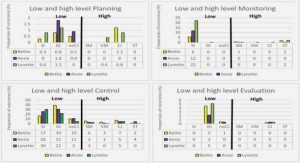Get Complete Project Material File(s) Now! »
Introduction
Thermal energy storage systems can shift demand from on-peak to off-peak periods by employing building thermal mass or with water chilled system, ice storage system and phase change materials. Without a thermal storage unit, the equipment has to be sized to meet the peak cooling requirements. Building thermal mass provides significant thermal storage potential and can be used to shift cooling to night time unoccupied periods but the demand savings by pre-cooling are sensitive to occupancy schedule, building construction, climate conditions and control strategy . Chilled water storage uses sensible heat capacity of water (1 Btu/lb ⁰F) to store cool energy. The practical minimum storage volume for chilled water is approximately 10.7 cubic feet per ton-hour at a 20°F temperature difference between water supplied to storage and returning from load [30]. Although being compatible with existing chillers there disadvantage is the requirement of large storage tanks .
Ice storage uses latent heat of fusion of water (144 Btu/lb) at 32⁰F to store cool. Depending on ice storage technology, storage volume ranges cubic feet per ton-hour. The low chilled water supply temperatures available from ice storage allow the use of cool air distribution, the benefits of which include the ability to use smaller fans and ducts and the introduction of less humid air in occupied spaces. Most common phase change materials store 41 Btu/lb at their freezing/melting point of 47°F with storage volume of 6 cubic feet per ton-hour. The 47°F phase-change point of this material allows the use of standard chilling equipment . The biggest disadvantage is that the tank typically cools the water for the distribution system to only 48–50°F, which accomplishes less dehumidification of the building and requires more pumping energy .
Ice Storage System Types and Their Control
Ice storage builds ice by chiller or refrigeration plant during off-peak hours to serve part or the entire on-peak cooling requirement. The latent heat of fusion of water (144 Btu/lb) is the highest among common materials, that is melting or freezing of one pound of ice at 32⁰F absorbs or releases 144 Btu of heat. The coolant which is circulated through the ice tanks to make ice is at a temperature of 15⁰F to 26⁰F. Ice storage systems include:
Ice Harvesting
In an ice harvesting system, ice formed on an evaporator surface is periodically released into a tank filled with return water to be cooled by ice. The cooled water is pumped from tank to meet the cooling load. Schematic of an ice harvesting system is available .
Ice-on-Coil External Melt
In an ice-on-coil external melt system, a refrigerant or secondary coolant such as glycol is circulated through submerged pipes or tubes on which ice is formed. The ice is melted from the outside by circulating the warm return water over the pipes discharging storage. Schematic of an external melt ice storage system is available. As the ice melts during the melting cycle its surface area decreases and hence the rate of thermal energy transferred from the ice to the tank water decreases. When approximately 50% ice remains on the tube, the tank’s water temperature begins to rise until all of the ice has melted. Suitable applications for external melt systems would be those which have higher loads at the start of the melting cycle and low loads at the end of the melting cycle. For proper tank operation the air agitation system is necessary. The bubbler, a positive displacement air pump is the most essential component which agitates the tank water during initial build up period and tank cool down .
Ice-on-Coil Internal Melt
Ice is formed on submerged pipes or tubes same way as it is formed in the external melt system. Here unlike the external melt system, ice is melted from the inside by circulating warm coolant through the pipes. The coolant gives away its heat to the ice and is then pumped through building’s cooling system or cools secondary coolant circulating through building’s cooling system. The tank water never leaves the tank. Schematic of an internal melt ice storage system is available at [33]. During the ice melting cycle the leaving coolant temperature first rises as the surface area of the heat exchanger is limited to the inside surface of the melting cylinder of ice, a small annulus of melted ice between the warm coil and 32⁰F ice. Later in the melt cycle the ice cylinders break and melt rapidly. Suitable applications for internal melt would be those, which have smaller loads at the start of the melting cycle and higher loads at the end of the melting cycle.
Encapsulated Ice
Water freezes and thaws in plastic containers enclosed in a tank as cold or warm coolant is circulated through the tank, conceptually similar to ice in the coil-internal melt system. Dimpled balls about 4 inches in diameter are common plastic containers. These dimples allow for contraction and expansion while the states are being changed between water and ice. The spherical shape allows high heat transfer area per unit of water being frozen. Schematic of an encapsulated ice storage system is available .The most common commercial technology is the internal melt system. The encapsulated ice system is also suitable for many commercial applications, whereas the ice harvesting and external melt systems are more common in industrial applications. Ice storage can be operated as full or partial storage.
Full Storage
In a full storage system, the entire on-peak cooling load is shifted to off-peak period, and the chiller storing the required cooling capacity during off peak period. The cooling load is met by storage and the chiller remains nonoperational during peak demand. The equipment first cost is high due to larger chiller and storage requirements but greatest savings can be achieved. The full storage system is suitable for a system with a short peak period or high demand charges during a peak period.
Partial Storage
In a partial storage system, the chiller and storage together meet the on-peak cooling load. Less electrical demand is shifted to off-peak period by partial storage but smaller chiller and storage is required. Partial storage is more favorable in commercial buildings where occupied and unoccupied periods are of similar durations. There are two types of operating strategies demand limiting and load leveling. Demand limiting: This strategy operates the chiller at a reduced capacity during peak demand. The chiller is controlled to limit the facility demand at the billing meter. Storage requirement and chiller capacity are larger than load leveling operating strategy. Load leveling: In a load leveling operating strategy the chiller runs 24 hours. As long as the load is less than the chiller output, it is met by the chiller only. When the load exceeds the chiller output, the excess is met by storage discharge. This strategy is useful where peak cooling load is much higher than average load. Partial storage can also be used as full storage if the cooling load is small enough, taking care not to deplete the storage before the on-peak period is over. Partial storage uses chiller and storage priority strategies to divide the load between chiller and storage. For the chiller priority strategy, storage meets the load only when the load exceeds chiller capacity. The chiller operates at full load continuously. For the storage priority strategy, chiller meets the load only when the load exceeds the total storage capacity. The chiller does not operate at its full capacity continuously. A combination of these control strategies may be used.
Simulation Tool
Demand Response Quick Assessment Tool (DRQAT) version 4.0.0 has been used for the modeling and analysis of the storage unit performance. Demand Response Quick Assessment Tool (DRQAT) has been developed by LBNL’s Demand Response Research Center funded by the California Energy Commission’s Public Interest Energy Research (PIER) Program and can be downloaded from . Large and medium-sized office buildings with non-storage and ice storage systems have been modeled in Demand Response Quick Assessment Tool (DRQAT) in diverse climate zones. DRQAT provides a graphical user interface and is easier to interact with. It has been designed for simulating large commercial buildings including offices and retail units. The tool uses EnergyPlus as the simulation engine. EnergyPlus computes whole building energy consumption taking into account climate, building form and fabric, internal gains and HVAC systems interactions and is certified to meet ASHRAE 90.1 Appendix G performance requirements. EnergyPlus has inherited simulation characteristics from both BLAST and DOE-2 programs. DRQAT requires simple building input parameters like the number of floors, the length and width of each floor, the window-to-wall ratio (WWR), the building location and orientation, the number of occupants and densities of internal loads (lighting and plug loads). DRQAT also allows users to model HVAC and internal loads schedules such as hourly schedules for internal loads, operating schedules of the HVAC system, zone temperature setpoints and temperature setpoints for chilled water, condenser water and supply air. This avoids the error prone process of writing EnergyPlus input files. Some of DRQAT’s output results exploited in this research include the daily and monthly chiller power consumption for conventional and ice storage cooling systems and the daily ice charge and discharge rates for the ice storage systems. However DRQAT models only commercial buildings for California climate zones and the building construction standards that are in compliance with California Title 24 construction standard. In order to model buildings in cities other than California representing diverse climate zones the weather and building construction files in DRQAT have been modified. The climate data and construction standards for selected cities representing diverse climate zones have been incorporated into DRQAT. Sensible heat can be perceived by the human senses , Latent heat is heat released or absorbed during phase change without change of temperature. WWR is the ratio of window area (glass area and frame) to the exterior wall area.
1. INTRODUCTION
1.1. Background
1.2. Research Objectives
1.3. Literature Search and Gap Analysis
2. ICE STORAGE SYSTEMS
2.1. Introduction
2.2. Ice Storage System Types and Their Control
3. METHODOLOGY
3.1. Simulation Tool
3.2. Climate Zones
3.3. Large and Medium-Sized Office Building Models
3.4. Sizing and Control of Ice Storage Systems
4. SIMULATION RESULTS AND DISCUSSIONS
4.1. Large-Sized Office Buildings Results and Discussions
4.2. Medium-Sized Office Buildings Results and Discussions
GET THE COMPLETE PROJECT
Impact of Ice Storage on Electrical Energy Consumption in Large and Medium-sized Office Buildings in Different Climate Zones




